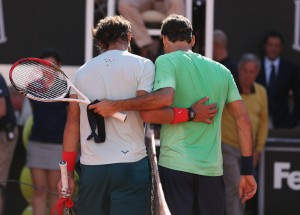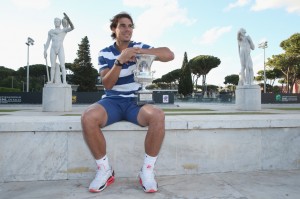Rome Masters, Final
(5) Nadal d. (2) Federer, 6/1 6/3
Rafael Nadal today won his seventh Rome title, in the process claiming his twenty-fourth Masters trophy and establishing a favouritism for Roland Garros so clear that to go on denying it would be to court ridicule. One could be glib, and point out that Roger Federer was there, too. But a more accurate assessment would be that Federer’s presence was fundamental to the final score, if not to the outcome.  The widespread assumption coming into the match was that the Swiss would probably perform adequately, and would therefore lose quite thoroughly. Instead he played awfully, which made it awkward to watch.
The widespread assumption coming into the match was that the Swiss would probably perform adequately, and would therefore lose quite thoroughly. Instead he played awfully, which made it awkward to watch.
Such matches present anyone determined to write about them with a problem, especially if that writer is eager to push the word count beyond four hundred yet avoid a verbatim reprisal of previous material. (The truth is that it would be more fun to write up the final of the Bordeaux Challenger, which turned out to be an excellent encounter between Gael Monfils and Michael Llodra.) Anything that can be said about Nadal’s clay court prowess has been covered exhaustively, and everything I wrote after last week’s Madrid final remains more than pertinent. Furthermore, one need not tarry overlong in deconstructing a result the players spent so little time putting together.
My alternative, therefore, is to digress. I can discuss broader trends, and examine how this result continues or bucks them, thus demonstrating profound wisdom. I can point out flaws in common knowledge, which allows me the warm glow of iconoclasm. There is also an opportunity to loft myself into rarefied allusion. This is an especially attractive option in the Italian capital, where few can resist the temptation to buttress their point with Roman precedent, or at least an ominous Latin quote or two. Indeed, as I’ve said, the Foro Italico owes its existence to Mussolini’s determination to make precisely such a point. It’s also a nice way to bring something a little different into the reporting of tennis, since too many tennis writers write like people who don’t read. If I’m really short on material I could discuss Federer’s haircut.
I suppose I should talk about the match a bit. The first game was Federer’s best, featuring five points, four of which were winners, and three of which were his. This failed utterly to foreshadow what was to come, except insofar as it revealed that Federer’s approach would entail all out aggression at any cost. The next six games were more indicative. Nadal won them all, looking perfectly superior in most neutral rallies, allowing Federer next to no free points on serve (I think the Spaniard missed one return in that first set) and emphatically answering any query Federer put to him. But it also revealed that the true cost of Federer’s relentless attack was an alarmingly mounting error tally. He finished that first set with fifteen.
A note should be made here. There is a persistent view that the unforced errors produced by Nadal’s opponents aren’t really unforced at all, but are a reflection of the pressure instilled by coping with his game, particularly on clay. Such arguments predate Nadal. Indeed, they’ve been kicking around for a long time, probably since people first began counting unforced errors. As an idea it gained widespread currency during Andre Agassi’s later career (the cloyingly monk-like part after he’d recovered from the allegedly degrading horrors of being very rich and famous). Agassi’s contract stipulated that anyone commentating his matches had to declare that his opponent’s errors were really inspired by the terror of seeing him planted up on the baseline. There’s probably something to this idea, but it’s also easy to make too much of it. A related truism is that great returners provoke more double faults, which seems self-evident, but isn’t actually borne out by the numbers.
The advantage of today’s match being so short is that one could watch it again. Doing so bore out my initial impression that Federer’s heroic error tally mostly reflected a tendency to over-hit, even on fairly simple put-aways from mid-court and at the net. Naturally his awareness of Nadal’s speed, anticipation and great hands inspired him to go for more than he would have otherwise – and Nadal hit some truly brilliant passing shots today, especially from the backhand – but we shouldn’t forget that a resume like Federer’s owes a lot to his ability to execute repeatedly under pressure. Today he didn’t. He produced another seventeen errors in the second set, bringing his total to a rather grand thirty-two. Nadal hit precisely one quarter as many.
Like I said, I can’t imagine a more modest selection of errors would have altered the result, though it probably would have made for a more interesting match. There was momentary interest when Nadal stepped up to serve for the title at 5/1 in the second set, and was promptly broken to love amid a sudden barrage from Federer, who then held. But any fears or hopes that this might spark a radical reversal were ameliorated or dashed when Nadal served it out comfortably.
His victory speech was typically gracious, and judging by the appreciative reaction of the local crowd, demonstrated a firming command of Italian. I’m hardly fluent, but even I could tell it represented substantial progress on his speech following he and Federer’s last final at the Foro Italico, in 2006. That day they’d collaborated on an all-time classic, with Nadal clawing back match points to triumph deep in a fifth set tiebreaker. Both men were so exhausted that they promptly pulled out of the Hamburg Masters the following week, which was subsequently won by Tommy Robredo, enabling him eventually to qualify for the Masters Cup (to Goran Ivanisevic’s very public disgust). This was held to be a crime against the sport, and gave the ATP an uncounterable argument for cancelling best of five set finals. In the long years since there have been many persuasive arguments that something was thus irreversibly lost. Today’s Rome final was not such an argument. Aside from Nadal’s fans, who understandably could have gone on watching all day, did anyone really want to see more of that?
Nadal has won three of the five Masters events played this year (Indian Wells, Madrid and Rome). Of the remaining two he reached the final of Monte Carlo and didn’t play Miami. He has now returned to the number four ranking, but based on these (and other) results it’s hard to argue he isn’t the best player in the world at the moment. With due acknowledgement for how well he is playing, there’s also substance in the contention that he’s the only one among his peers who is. Federer is now healthy, but his form remains terribly patchy, as we saw today. Murray is injured, and seems to me to have relapsed into bad patterns. Djokovic, aside from a few masterful tournaments, seems uncannily like the old version of himself from before 2011. Indeed, much of the top ten is out of sorts. Tsonga is all over the place, Del Potro has pulled out of the French Open, and Berdych only ever looks imposing until he reaches the semifinals. Tipsarevic seems to have forgotten how to play at all.
Beyond that, there are signs that the top four’s unprecedented stranglehold on the big events, at least at Masters level, is starting to loosen. They’re still winning them, of course, having claimed 28 of the last 30 (with the remaining two being won by the world number five at the time). But they seem to be losing more often before the finals and semifinals, and players as various as Paire, Wawrinka, Janowicz, and Haas are now pushing deeper. I don’t think I’m alone in hoping this signals a broader movement towards more variety at the business end of big events. Whether it’s old or new blood, tennis right now could use some fresh blood.
Inevitably, the question has been aired of precisely what this result means for Federer’s legacy, both this particular match, and the broader implications of his head-to-head with Nadal. Announcing Federer’s decline has become something of a cottage industry in recent years, and I imagine there are commemorative tea-towels available somewhere. I don’t pretend to know how he feels about any of it, and as a rule I have no time for the practice of pulling apart a person’s career while that person is still busy putting it together. It’s a tendency that has grown particularly common in recent times, unsurprisingly in an age when celebrities and sporting luminaries are encouraged to publish their memoirs before they turn twenty-five. For what it’s worth, my view is that Federer is probably the best player ever to have played, and in his prime he was the second-best clay courter of his era. The result was that he often reached clay court finals, and there discovered arguably the most accomplished and ferocious clay courter of all time. Had Federer been a worse clay courter, and reached fewer finals, like Sampras, his head-to-head with Nadal would have ironically looked much better. Mostly, however, it is a fatuous debate, and I find it about as diverting as discussions of Federer’s hairstyle. If the debate must be held at all, it will only make any kind of sense after they’ve both retired, and even then it’s doubtful.
Nonetheless, the debate continues because the pursuit of prestige is eternal, and easily understood. Indeed, it was something the Romans understood in their bones, since it underpinned their entire society. Lives were lived in order to ensure a heightened legacy. The very streets near where Federer and Nadal today fought often burned or stank with corpses as avowedly great men dissolved the city in blood and flames for nothing more than their own ambition. Plutarch has it that when Gaius Marius commenced his seventh consulship by turning Rome into a charnel house, he grew unhinged with fear at the thought of Lucius Sulla returning to exact vengeance, rapidly succumbing to nightmares and dementia:  ‘Dreadful, indeed, is the lions’ lair, even though it be empty.’  This line always reminds me of the Rome Masters, where a player might thrive for a time, but eventually must face Nadal.
This line always reminds me of the Rome Masters, where a player might thrive for a time, but eventually must face Nadal.
In any case, it’s naive to hope one’s legacy will remain intact even after it is completed, in this age or any other. No man in the entire history of the Republic had achieved greater renown than Marius, but when Sulla eventually did make it back to Rome, he ordered Marius’ bones publicly exhumed, and unceremoniously tossed into the river. Nothing lasts forever, or even for very long. Little did Sulla guess that in time the crucial differences between he and his rival would be forgotten, until both were held merely to be representative of their age. Perhaps they were: whereas Sulla and Marius once fought side-by-side desperately to repel the invading Teutons, twenty-one centuries later Mussolini welcomed the Wehrmacht with open arms. I’m not sure what to make of that. Perhaps nothing. In time, Nadal and Federer will seem more alike than not, and the debate over who was better will merit no more than a footnote. In the meantime, you’ll note that the urge to legitimate one’s work with references to eternal Rome is an indulgence not confined to dictators, and extends to tennis writers.

15 Responses to ‘Dreadful, indeed, is the lion’s lair…’